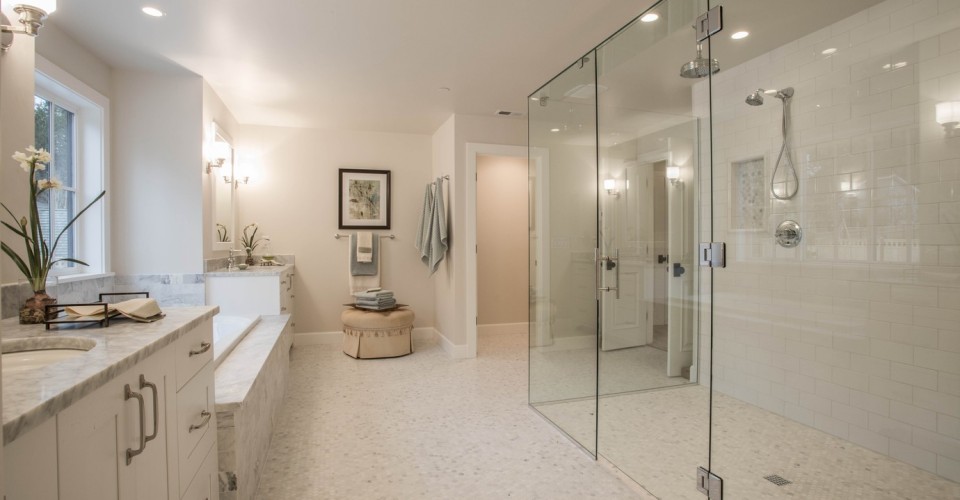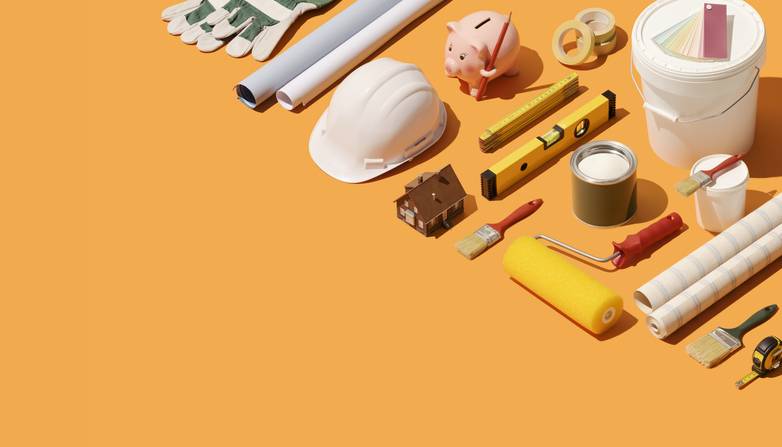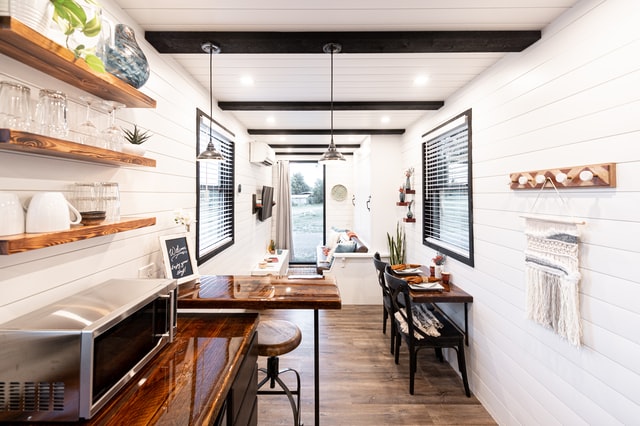The privacy, comfort, luxury and extreme sanitary conditions that we associate with our bathrooms today are the result of thousands of years of civil engineering and social change. Indoor plumbing, flushing toilets, heated water, water pressure, electricity and ventilation may be features we take for granted in our modern bathroom. But all of our bathroom’s high tech gadgets had a long history in the making. Although humans have always had the need to use toilet facilities and have used bathing as a way to cleanse themselves, it took centuries for our culture to bring these two important functions together into one convenient room. Let’s explore the fascinating history of the bathroom and see how much, or how little, has changed.
Ancient Societies and Public Bathing
When we talk about the activities we perform in our bathrooms today, we tend to speak of everything that relates to taking care of our bodies: washing, bathing, cleaning, relieving ourselves, manicuring our outer appearance…it’s a place we cleanse ourselves, ensure proper hygiene, and a place we prepare ourselves for the day. In ancient cultures, these tasks weren’t necessarily performed all in the same room. In many societies, the toilet was a function performed far away from the home. And cleaning or bathing the body was performed in another area. Bathing played an important role in many societies as water was often used in religious or political ceremonies. Of course, each society had a unique version of cleansing; let’s take a look at some well-known traditions.
Ancient Rome
The famous Roman baths, and the ritual of bathing, was a tradition that extended as far as the Empire itself. Ruins of ancient Roman baths have been found in England, Northern Africa and the Middle East. To the Romans, bathing was a public ritual, an opportunity to socialize, take care of the body, and rub elbows with the elite. Similar to our modern day golf club or country club, the Roman bath was considered absolutely mandatory for a certain class of people. Roman baths were derived from ancient Greek bathhouse design and usually featured large facilities in addition to smaller rooms. There was usually a reception area (apodyterium), a hot room (caldarium), a warm room (tepidarium), and a cold room (frigidarium). Some baths featured other rooms for steam, sauna or exercise. Men and women usually bathed separately and used different entrances. Because the Roman baths were such an integral part of their empire, its history and archeological sites have helped shed light on what life may have been like back then. Bathing, it seems, was performed for hygienic reasons, but also reflected a certain level of importance for the middle and upper classes. Some of the best-preserved ruins of a Roman bath can be seen in Rome and Pompeii.
Many Roman baths took advantage of natural hot springs but the Romans were also skilled civil engineers, with aqueducts supplying fresh water not only for agriculture and drinking fountains, but for baths as well. The bathhouses were so important for many cities that they often incorporated spaces for exercise, libraries, lecture halls and gardens. There was a therapeutic aspect to Roman bathing as well as an educational one.
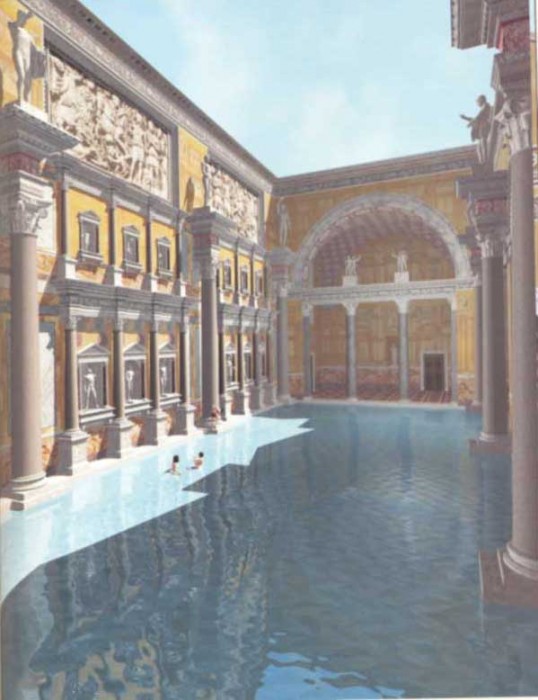
The Baths of Caracalla were built between 212 and 219 A.D. by the emperor Marcus Aurelius Antoninus. Image found here.
Middle East
The Romans introduced the idea of the public bathing throughout their empire, which included Northern Africa and the eastern Mediterranean countries. As the idea of public bathing slowly died out in the west, the east continued the tradition with their hammam, or public baths. One of the oldest surviving hammams is the Hammam al-Nahhasin located in Syria, which dates back to the 12th century. Like ancient Rome, the hammams in the east were an important part of the culture and their presence seemed to signify a prosperous city. It was noted by medieval authors that ancient Baghdad had nearly 60,000 bathhouses at its height of prosperity. During the late medieval period, western travelers to the east re-discovered the public baths and introduced them back into European culture.

This Iranian public bathhouse, located in Kashan, Iran, was constructed in the 16th century. “Sultan Amir Ahmad Bathhouse 2” by Adam Jones. Licensed under CC BY-SA 2.0 via Wikimedia Commons.
Baths in the West
European crusaders, who traveled to the east between 1095 and 1291, brought back home to England citrus fruits and herbs as well as the love of steam baths.
England in the Middle Ages favored steam baths and bathing, and many social activities took place in and around the “stews,” or baths. Men and women could bath together (however women may have covered their hair for decency). Dining, grooming and other social activities were common scenes at the stew (as depicted in the image below). Contrary to modern belief, the medieval people in England were quite clean. But like many trends, public bathing in England fell out of favor at the end of the 16th century as the bagnios/bagno, or baths became associated with brothels. Another reason public bathing was falling out of favor was that the sudden increase in population was making it difficult to find clean water. As waves of disease hit Europe in the Middle Ages (the most famous being the Bubonic Plague otherwise known as the Black Death in 1347), it was believed that bathing, and exposing the body to water, may contribute to early death.
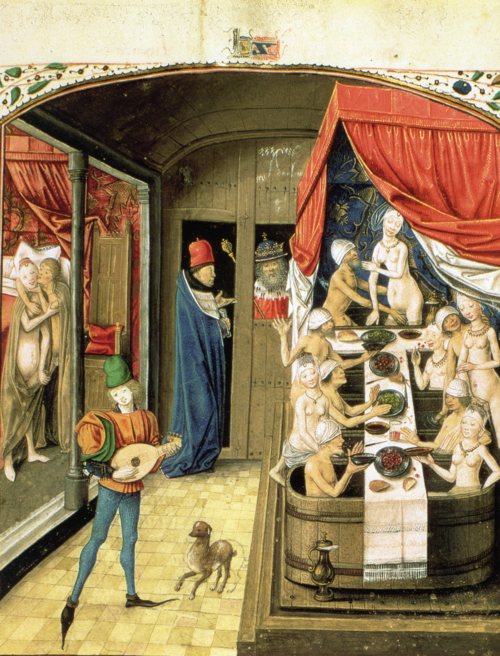
An English stew. Luxuries: A Bathhouse in Valerius Maximus’ Facta et Dicta Memorabilia (fol. 244), c. 1470, tempera and gold leaf on parchment. Staatsbibliothek zu Berlin—Preussischer Kulturbesitz (Depot Breslau 2). Image found here.
Medieval Japan
The bathing rituals in medieval Japan were well documented by traveling Europeans who traveled to the islands. It was noted that bathing was not only common but encouraged, both for religious reasons and social ones. Like many ancient cultures of the time, bathing could have been centered on religious ceremonies. Zen monasteries used bathing to cleanse the body and mind as well as a place to meditate. It was common to see “charity” baths, donated and constructed by the wealthy for use by the poor.
In medieval Japan several types of therapeutic baths were used by all classes, many of these baths were created not necessarily because of wealth but because of geographical advantages. Natural hot springs were one type of therapeutic bathing (and is still being used today). Another type was rock bath, which originated near the Inland Sea. This was an early form of a steam bath, in which stone enclosures were heated and then poured over with salt water. The resulting steam and salt was thought to be therapeutic. A third type of bathing, the oven bath, was similar to a sauna or steam bath and found in the mountain regions. A clay hut, similar to a large oven, was heated with green branches. The ashes were raked away and a person would lie down inside on a mat that had been soaked in water. The heat and steam would be sealed off, resulting in a therapeutic steam/sauna experience.

An image depicting a Japanese medieval charity bath at a Buddhist temple, circa 1326. Image found here.
Ancient Toilets
Ancient civilizations most likely used both a portable system, like a chamber pot, and a public toilet system. Squat toilets, still in use today, have been discovered in Asia dating as early as 1500 B.C. Of course where you lived and your status within your society may have dictated the level of comfort or privacy of your toilet. Some ancient public toilets, like this one pictured below in Ostia Antica, Italy, give us a good idea about what toilet life was like back in the Roman Empire. For the most part, our modern concept of privacy when using the toilet is relatively new. It’s true that the most powerful or wealthy may have been able to use the toilet in relative privacy. But for the lower or middle classes, nearly all aspects of life was commonly shared. Like we explored in the history of the bedroom and kitchen, shared activities was a way to foster relationships, establish bonds and share communal life.
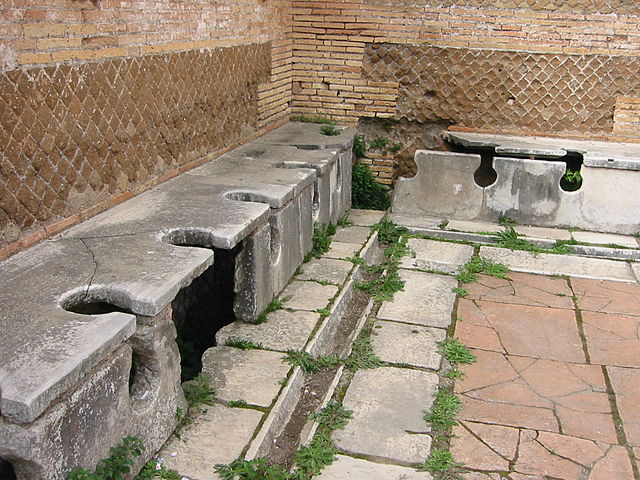
“Ostia-Toilets” by Fubar Obfusco – en.wiki. Licensed under Public Domain via Wikimedia Commons
You can still see private toilet seats in European castles. Much like a modern port-a-potty, garderobes were a wood or stone seat in which the toilet debris could fall down a cute into a moat below. A medieval garderobe was much like a small closet, used to store clothing and other wearables. But some featured a stone seat for use as a toilet (like the one shown below). Medieval cities may have situated public toilets on bridges, so that the toilet debris could simply float away with the river. Ancient Romans were known for having chamber pots available during dining events (which could last hours). There is evidence of using natural materials (whatever was available in that region) for wiping. Sponges on a stick, rushes or weeds, or even pieces of linen cloth may have been used. And what you used, and how expensive it was to produce, would have reflected your status within society.
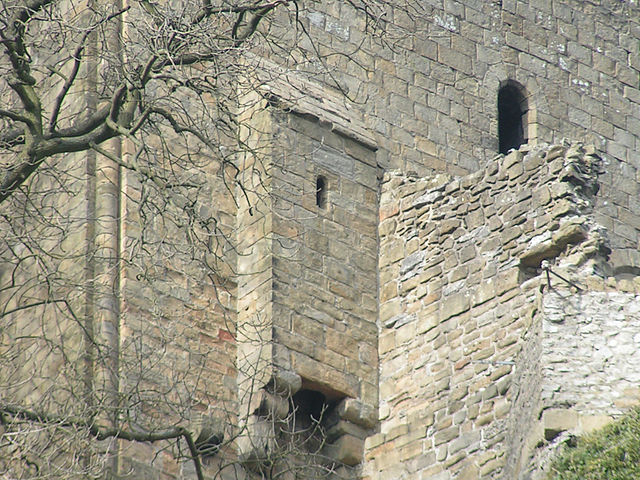
The garderobe shown at Peveril Castle, circa 1086. “Garderobe, Peveril Castle, Derbyshire” by Dave.Dunford. Licensed under Public Domain via Wikimedia Commons. Image found here.
16th Century Europe: No baths, flushing toilets invented
The plague hit England 7 times in 200 years and greatly impacted public opinion of bathing, hygiene and cleanliness. In 1546 King Henry VIII shut down public bathhouses in England for good, blaming them for sickness. Instead of bathing to keep clean, it was thought that wearing clean linen next to the skin would make the body clean. As a result, laundry and washing became incredibly important (as well as time consuming) for the women in Tudor England. Brilliant white, as seen in portraits of the day, became a status symbol.

Image of Queen Elizabeth I (1533-1603) showing off her brilliant white clothing. Painting by Marcus Gheeraerts.
Instead of bathing, white linen underclothes, soaking up toxins and smells, became the solution of keeping the body clean. Washing these linens was laborious. Soap was made from water poured over ash and boiled with mutton fat and herbs. This recipe created a ball of scented soap lye that could be rubbed on linen and clothing. A flat paddle, called a washing bat or beetle, was used to hit the clothing during the washing process – an old style of washing clothes. It is thought that Tudor children may have used these balls of soap and beetle bat in a game, like cricket. Urine was also used as a whitener or stain remover. Because bathing the body was a rare occasion, it was common for people to carry pomades made from citrus fruits, spices and vinegar that would help mitigate body odor. As far as other bodily hygiene was concerned, teeth were cleaned regularly with a paste made from cloves, salt, burnt toast or vinegar in various combinations.

A painting depicting 16th century laundry. Notice the beetles used to hit the clothing. Image found here.
There were basically three types of toilets in the Tudor period and who used them was decided entirely upon the status of that person. There were Great Houses of Easement or communal privies, which were public toilets for the lower class. These toilets, like the ones before them, were often situated over rivers and enclosed in a bridge-like structure. Chamber pots were used by the middle class and would have been emptied onto the street or river. Chamber pots were considered to be discrete and somewhat private, as the person could use them in their bedroom or whichever room they chose. Women wearing large skirts could actually place a chamber pot up their skirts and use the chamber pot in relative privacy. The wealthy royals used velvet-lined clothes stools with a chamber pot inside. They would be attended by servants who would bring the clothes stool to the person and then wheel them out when finished. Queen Elizabeth I even had a carriage for her clothes stool so that it could be brought with her wherever she went. The servants who would be chosen to attend to the semi-private chambers of the royal family, the Privy Council, played a very important role. The lord of the chamber (which later became Lord Chamberlain) was quite literally the person in charge of attending the king while on the toilet or while using the private chambers. Being physically close to the king had enormous privileges.
In 1596 a wealthy poet, and godson to Queen Elizabeth I, Sir John Harrington, invented Britain’s first flushing toilet. He published a book called A New Discourse of a Stale Subject, Called the Metamorphosis of Ajax. “Ajax” being a play on the Tudor word for toilet, “jax.” The basic engineering of this first flushing toilet isn’t too far different from today’s toilet and because of his relationship to the queen it was installed in the castle. Unfortunately, it was not a hit. The royals were used to the toilet being brought to them, and this new device could not be moved. The queen did not want to walk to a room specifically for using the toilet – that would have been seen as lewd and too obvious. Additionally, this toilet didn’t flush after every use and had no device to prevent fumes and smells from rising. So although this toilet design was incredibly inventive, it did not catch on among the wealthy. Still, Elizabethan London was becoming polluted with human waste. 180,000 people lived in London at that time and there became a strong need for fresh water to be piped into the city to help with the stench.
The 18th century: The bathroom as a social place
Bathing was still not a daily ritual for many westerners during this time. As London was seeing the development of its first massive irrigation project being installed, the wealthy could pay for private fresh water taps to be placed into their homes. This did not mean that these homes had access to fresh water every day, however it did mean that bathing, cleaning and washing could be done more privately inside the home.
Across the pond, George Washington noticed that the hygiene of his troops was deplorable and feared that unsanitary conditions could lead to disease. He wrote to one colonel, “While you halt you will take every measure for refreshing your Men and rendering them as comfortable as you can. Bathing themselves moderately and washing their Cloathes are of infinite Service.” (source) In fact, the British Royalists who would visit the Colonists often remarked on their odor and deplorable, unsanitary conditions. Not used to the humidity of the American south, some British colonists did find time to bath in cold water if only to escape the heat of the summer. But bathing on a regular basis was not a common practice.
In Georgian London, many of the rituals that we perform in our bathrooms today were done in the bedroom. Washbasins, set on elaborately designed and expensive stands, would hold water for washing the extremities. This area of the bedroom would have also been used for makeup, perfume, putting on wigs and general dressing. Unlike our bedrooms and bathrooms of today, these dressing tables were places where social activities took place. It was common for men and women to get ready in their bedrooms while socializing with their friends. The rising middle class created a demand for interiors that reflected their rising status in society, and no shortage of money could be spent on lavish vanities. Although not considered private, this corner of the bedroom was essentially their bathroom.
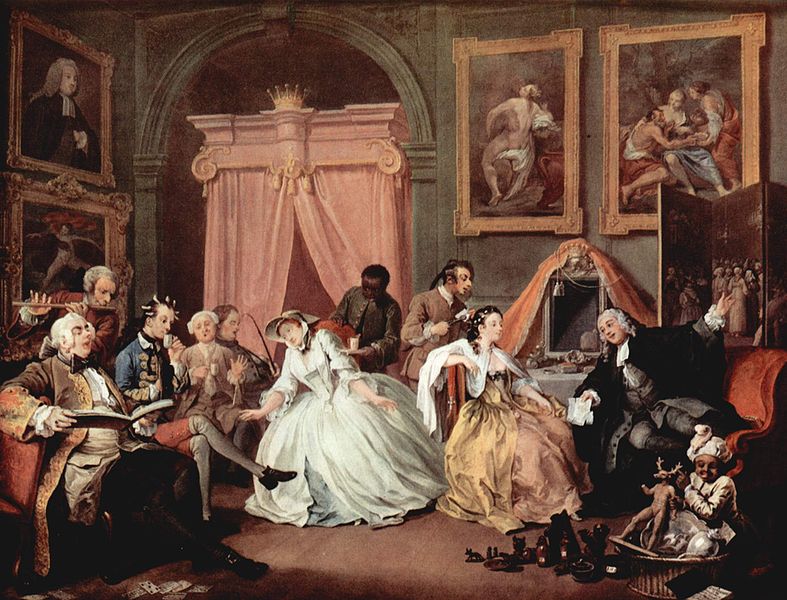
A scene depicting entertaining while sitting at the vanity. In the 18th century it was common to get ready for the day in the bedroom while eating, writing letters and socializing. Image found here.
The wealthy may have spent lots of time and money putting on makeup, dressing in elaborate clothing and using copious amounts of perfume, but bathing for hygienic reasons still wasn’t popular. Medical knowledge of health and disease still was in an infant stage of discovery. There were some that believed bathing to be the source of disease, and others who believed that bathing could be therapeutic. Some doctors prescribed bathing only in cold ocean water, others prescribed bathing in hot springs. “Taking the waters” was a prescribed activity for the sick and many believed (and still believe) in the powers of natural mineral springs. In 1742 the Mineral Water Hospital was opened in Bath, England (which was originally used as a bath by the ancient Romans in 60 A.D.) and was used to treat the seriously ill. By 1801 the town of Bath had grown to 40,000, making it one of the largest cities in England.
1750-1900s: Industrial Revolution and the issues of removing waste
Flush toilets received a huge advancement in technology when in 1775 Alexander Cummings, a Scotsman, invented the S-trap. This device, still in use today, allowed for water to be trapped within the plumbing, preventing the escape of the stench from the sewers below. The flush toilet design continued to experience new experiments with designs and inventions throughout the 1850’s. One inventor, Thomas Crapper, developed a patent for a flush toilet design however he was not the sole inventor of the flushing toilet. And contrary to popular belief, his name is not where we get the word “crap.” (Crap was another word for rubbish.) Toilet designs were being introduced by a number of manufactures with names like “The Revolver,” “The Oracle,” “Deluge,” and “Dreadnought.” The great Expo of 1851 hosted in London showcased the very best of the rising Industrial Revolution and cast a wide influence on America. Gas lamps, the kitchen range, and all manner of technological advancements showed people how their life could be made easier and more comfortable with technology.
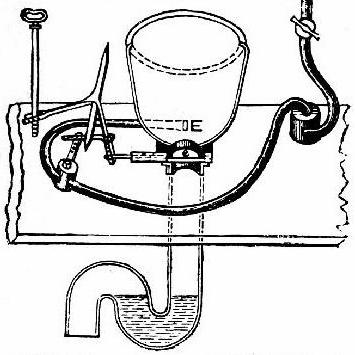
“Cummings S-bend” by Alexander Cummings invented in 1775. Original publication: Patent applicationImmediate source. Via Wikipedia . Image found here.
The popularity of the flush toilet inside the home was creating major problems for the waste system in major cities. Nowhere was this problem seen more than in London. Although the toilet was advancing in design, the ability for cities to both pump fresh water in and remove waste away, was not. Many cities throughout Europe and America stunk, and the need for an advanced sewer system became vital to public health. Although ancient cities, like Harappa, had a complex network of sewage drains dating from 2600 BC, it took the West a long time to construct an efficient way to remove waste (and stench) from booming cities. England, being the first to experience the industrial revolution, was the first to engineer the modern sewage system. London’s sewer system was begun in 1859 by Joseph Bazalgette, a civil engineer. In America, the sewer system was also begun in the 1850’s in Chicago and Brooklyn. The first sewage treatment plant in America was built in 1890 in Worcester, Massachusetts, when it became apparent that raw sewage could lead to epidemics of typhoid and cholera. Treating sewage prior to dumping it into the water system became the new method of removing waste.
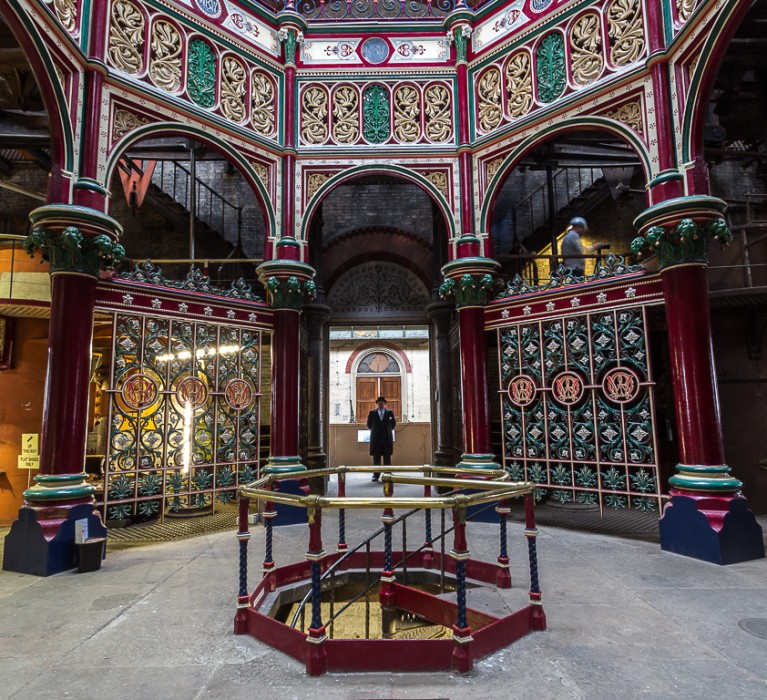
The Crossness Pumping Station was designed by Joseph Balzalgette in 1859 as part of the development of London’s sewer system. Notice the Victorian iron work design. “Crossness Pumping Station, Belvedere, Kent” by Christine Matthews. Licensed under CC BY-SA 2.0 via Wikimedia Commons. Image found here.
With a modern sewage system in place, newer homes were constructed with a dedicated toilet, sometimes several toilets. Plumbed water was added and the concept of the bathroom, or water closet, was created. But despite the convenience of a private bathroom, behavior didn’t change so quickly, especially in prim and proper Victorian England. For women, large hoop skirts were difficult to pull up when sitting on the toilet, and it was considered far more comfortable (and more discrete) to continue to use the chamber pot in the privacy of the large bedroom. And a lady wouldn’t have wanted to make a noticeable trip to the toilet – this would have been seen as immodest. But despite any old-fashioned beliefs of privacy, the need for indoor plumbing, particularly for the toilet, was becoming a necessity as cities became more populated and vertical. There was less and less space for public facilities and Victorian attitudes demanded sanitary conditions, even for the poor. The toilet, which had taken centuries to accept, had finally become considered a necessity to have, regardless of your status in society.
Health and hygiene were hot topics of the day, and with a flushing toilet and sewer system removing horrible stench, other demands were being created, like the need for toilet paper. When the toilets were simply holes in the ground, it did not matter much what you used to wipe yourself clean. But flushing toilets used pipes that were narrow and the plumbing couldn’t handle large wads of newspaper, corncobs, moss or catalog paper. Joseph Gayetty, from New York, invented the first paper product designed specifically for wiping in 1857. However it was expensive, and people didn’t immediately see the need to buy it. In 1890 Clarence and Irvin Scott designed a perforated roll of paper for use in the water closet. Their product was sold to hotels and other distributors with various names printed on the package. (Embarrassed by the “lewd” product, they didn’t even put their name on the package until 1903.) Americans were slow to make this new product a success, and were embarrassed to be seen purchasing a product specifically for the toilet. It wasn’t until the 1930’s that toilet paper sales began to take off, thanks in part to ad campaigns directed at women.
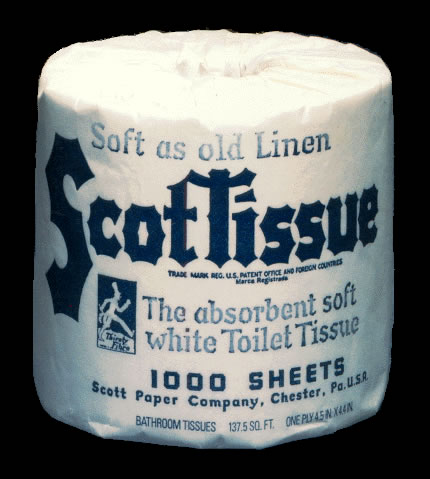
A vintage roll of Scott Tissue, invented by the Scott brothers in 1890. Image found here.
The Late 19th and Early 20th Centuries: Germs and hot water
The late 19th century brought about advancements in technology as well as advancements in medicine. The discovery of germs and a more specific cause for disease changed the way people thought about cleanliness and hygiene. Taking a bath and cleaning the body with soap was now generally thought of as a necessity for good health. As more homes were plumbed for water and gas heaters became widely available, the middle class started to experience the joy of bathing inside the home. Lower classes living in dense tenement buildings still shared bathtubs, toilets and laundry facilities, with sometimes just a few toilets per building. It was common that the entire family shared one tub of water: the most important person of the household (the father) would bathe first, then the mother, then the children. The expression “don’t throw the baby out with the bath water” probably came from this period of time when babies were bathing in the (most likely murky) bath water.
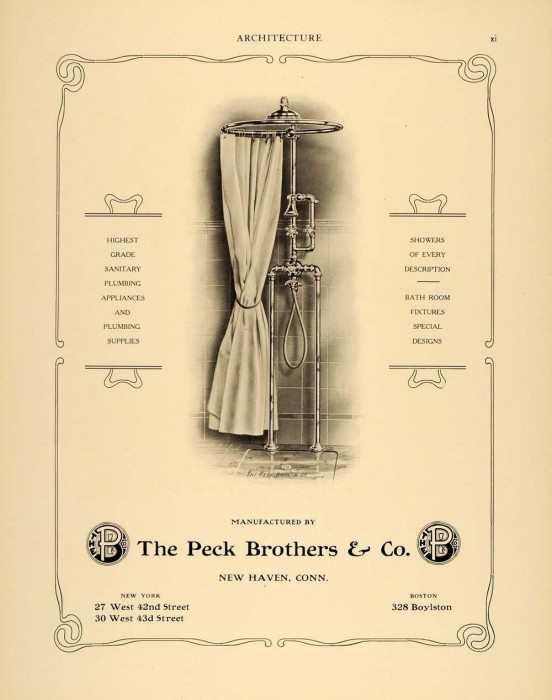
A 1905 advertisement for a shower. Image found here.
In America, homes of the wealthy were also being fitted with private bathrooms, bathtubs and showers but surprisingly, the wealthy upper class in England didn’t see the need for plumbed hot bath water. With servants to perform the laborious task of heating individual pots of water, there was no need to install expensive plumbing. American heiresses who married British royalty during the turn of the century must have found it odd that their new manor houses didn’t have plumbed bathrooms. Showers were also introduced during this time and initially they were operated with a hand pump. But by the 1850’s a properly plumbed home had sufficient water pressure and gas-powered heat to operate a shower very similar to our modern versions. By 1915, Sears Roebuck was selling showers for the home.
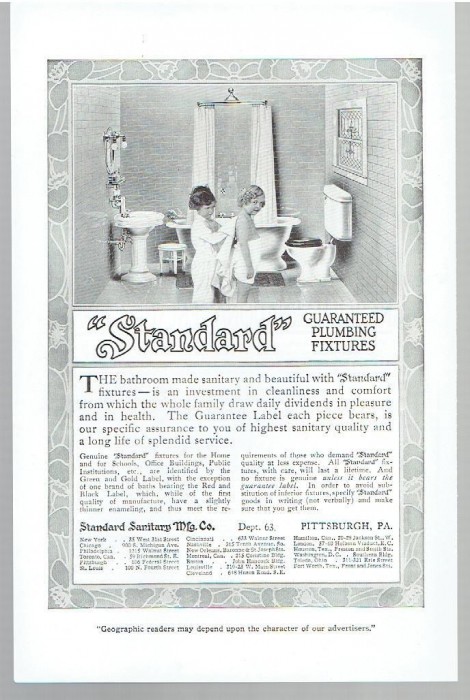
An ad from 1913 depicting sanitary and reliable plumbing fixtures for the home. Image found here.
The 20th Century: Bathrooms as places of luxury and privacy
After World War I and II, the glamour of Hollywood movies and the rise of the middle class demanded certain luxuries in the bathroom. Like the kitchen, the bathroom was becoming a source of pride, especially for the woman of the house. Although hair and makeup vanities still largely remained in the bedroom, the bathroom was the scene for relaxing and taking care of one’s body. The aspirational housewife of the 1950’s, along with the US housing boom, meant en suite bathrooms for the parents and separate bathrooms for the children. There was a demand for color, pattern, tile and beauty in the bathroom. Escapism was another popular use of the bathroom and it represented privacy and retreat.

1923 bathroom fixture advertisement, showing glamour and beauty in the bathroom. Image found here.

A Bon Ami ad from 1935 depicting household pride in the bathroom. Image found here.
Post WWII America saw new technologies enter the home space on a massive scale. Inventions like hairdryers, ventilation fans, new dental and toiletry products and an increase in the makeup and hair industries flooded the bathroom. New neighborhoods, plumbed for hot water and connected to sewer systems, meant that having access to hot water was expected. The 1960’s saw the advent of the sexual revolution and Jacuzzi’s and sumptuous shaped tubs became commonplace. Styles of the bathroom continued to mirror societal and economic changes that were taking place. The number of bathrooms installed in US homes also increased. According to the US Census, in 1973 40% of homes being built featured 1.5 baths or less, and only 19% had 2.5 baths. In 2013, only 5% of newly constructed homes were built with 1.5 baths and 32% featured 2.5 baths (with another 33% having 3 baths or more).

By the mid-1900’s, homeowners expected running water in their homes. This ad from 1961 shows how the bathroom, now with plenty of access to water, could be a space for play. Image found here.
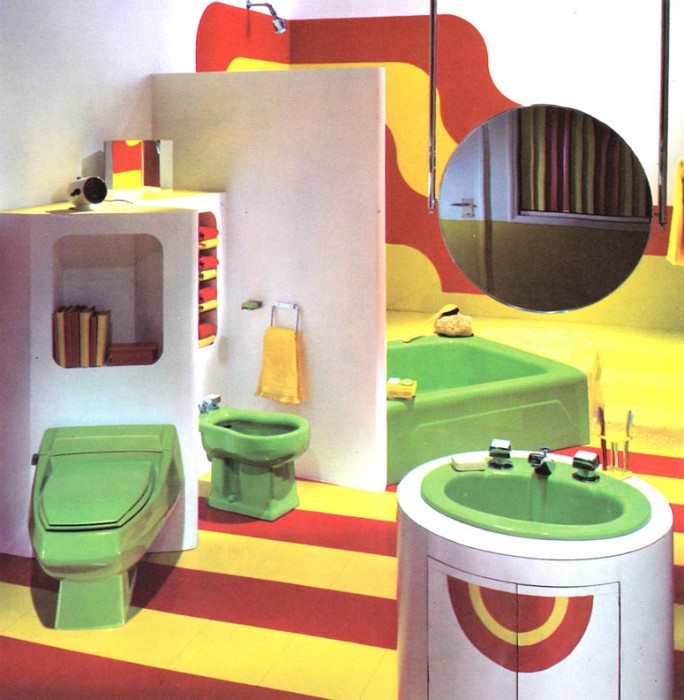
This bathroom from the 1970’s shows how interior design allowed for personal style to influence the bathroom. Image found here.
The bathrooms of today: Larger size and more technology
Today we see more and more technology entering the bathroom. Sensors for automatically turning on lights, multiple shower heads with programmable temperatures, stereo equipment and televisions, steam-free mirrors, refrigerated medicine cabinets and in-floor heating have certainly created spaces of extreme luxury and comfort. Bathroom styles of today range from relishing the handcrafted details of older styles (claw foot tubs, pedestal sinks) to the ultra modern (rain shower faucets, infinity edge bathtubs). Visit any bath fixture showroom and you’ll be astounded at the options for our bathrooms today. One of the most welcome features of today’s bathroom are the new standards for conserving water. As more US cities enter water year-round water restrictions, it’s important that homeowners recognize that bathrooms account for nearly 25% of household water consumption (you can take this interactive quiz to see how much water your home uses). WaterSense labeled toilets, for example, use just over 1 gallon of water per flush whereas toilets installed prior to 1995 use nearly 6 gallons per flush.
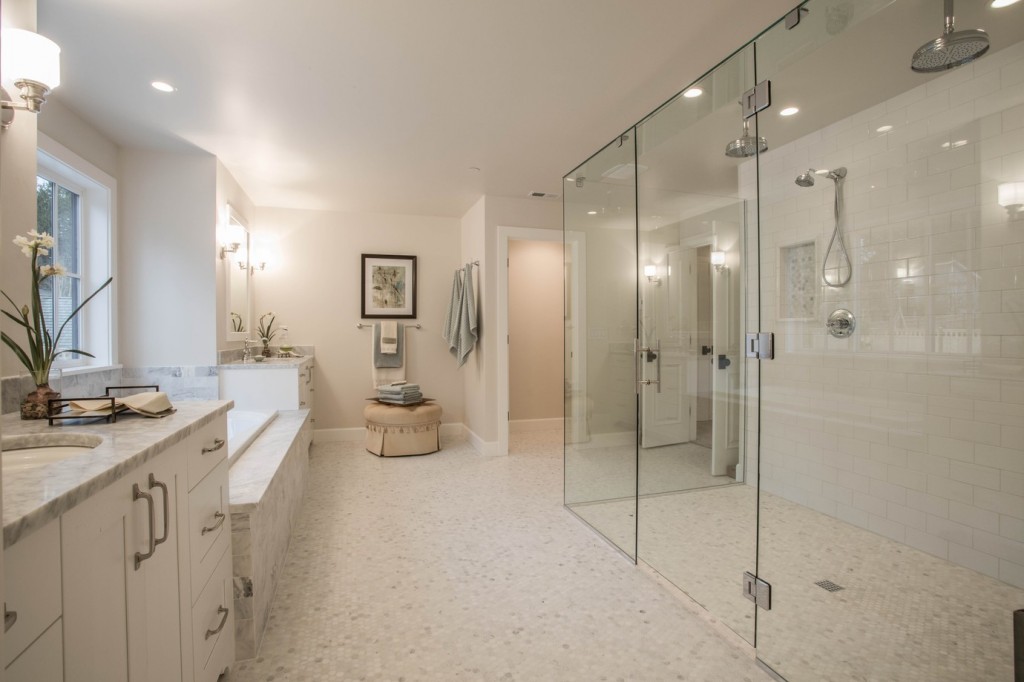
A large and fully-fitted master bathroom, designed in 2014. By Calista Interiors.
Modern bathrooms are also gaining in square footage. Today’s master bathrooms often include walk-in closets, dressing areas, his and her sinks, a shower and bathtub that can fit two people and a toilet. Often these master bathrooms offer commanding views out the window, just like our living rooms and kitchens. Homeowners also have the luxury of materials from all over the world, allowing us to truly personalize our bathroom space. Unlike bathrooms from the 18th century, our bathrooms are quite private spaces. Homes are generally constructed with powder or guest bathrooms, so that our master bathrooms can remain off-limits to everyone except the owners of the home. Even older homes are being retrofitted to accommodate more private bathroom retreats. Some homeowners even give up an extra bedroom in order to expand their master suite to include a much larger, and more private bathroom.
Tell us what you think about bathrooms of today – where do you see trends moving? What bathroom features of the past would you like to see today?
Read more about the history of the bedroom and the kitchen.
